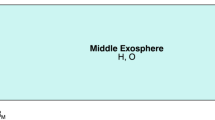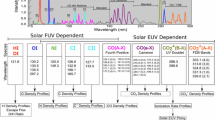Abstract
The Extreme Ultraviolet (EUV) monitor is an instrument on the NASA Mars Atmosphere and Volatile EvolutioN (MAVEN) mission, designed to measure the variability of the solar soft x-rays and EUV irradiance at Mars. The solar output in this wavelength range is a primary energy input to the Mars atmosphere and a driver for the processes leading to atmospheric escape. The MAVEN EUV monitor consists of three broadband radiometers. The radiometers consist of silicon photodiodes with different bandpass-limiting filters for each channel. The filters for the radiometers are: Channel A: thin foil C/Al/Nb/C for 0.1–3 nm and 17–22 nm, Channel B: thin foil C/Al/Ti/C for 0.1–7 nm, and Channel C: interference filter for 121–122 nm. A fourth, covered photodiode is used to monitor variations in dark signal due to temperature and radiation background changes. The three science channels will monitor emissions from the highly variable corona and transition region of the solar atmosphere. The EUV monitor is mounted on the top deck of the MAVEN spacecraft and is pointed at the Sun for most of its orbit around Mars. The measurement cadence is 1-second. The broadband irradiances can be used to monitor the most rapid changes in solar irradiance due to flares. In combination with time-interpolated observations at Earth of slower varying solar spectral emissions, the broadband MAVEN EUV monitor measurements will also be used in a spectral irradiance model to generate the full EUV spectrum at Mars from 0 to 190 nm in 1-nm bins on a time cadence of 1-minute and daily averages.






Similar content being viewed by others
References
L. Andersson, R.E. Ergun, G.T. Delory, A. Eriksson, J. Westfall, H. Reed, J. McCauly, D. Summers, D. Meyers, The Langmuir Probe and Waves (LPW) instrument for MAVEN. Space Sci. Rev. (2014, this issue). doi:10.1007/s11214-015-0194-3
S.M. Bailey, T.N. Woods, C.A. Barth, S.C. Solomon, L.R. Canfield, R. Korde, Measurements of the solar soft X-ray irradiance by the Student Nitric Oxide Explorer: first analysis and underflight calibrations. J. Geophys. Res. 105(A12) (2000). doi:10.1029/2000JA000188
P.C. Chamberlin, T.N. Woods, F.G. Eparvier, Flare irradiance spectral model (FISM): daily component algorithms and results. Space Weather 5(6) (2007). doi:10.1029/2007SW000316
P.C. Chamberlin, T.N. Woods, F.G. Eparvier, Flare irradiance spectral model (FISM): flare component algorithms and results. Space Weather 6(5) (2008). doi:10.1029/2007SW000372
E.M. Gullikson, R. Korde, L.R. Canfield, R.E. Vest, Stable silicon photodiodes for absolute intensity measurements in the VUV and soft X-ray regions. J. Electron Spectrosc. Relat. Phenom. 80 (1996). doi:10.1016/0368-2048(96)02983-0
B.L. Henke, E.M. Gullikson, J.C. Davis, X-Ray interactions: photoabsorption, scattering, transmission, and reflection at \(E=50\mbox{--}30{,}000~\mbox{eV}\), \(Z=1\mbox{--}92\). At. Data Nucl. Data Tables 54 (1993). doi:10.1006/adnd.1993.1013
R. Korde, J. Geist, Quantum efficiency stability of silicon photodiodes. Appl. Opt. 26 (1987). doi:10.1364/AO.26.005284
R. Korde, L.R. Canfield, B. Wallis, Stable high quantum efficiency silicon photodiodes for vacuum-UV applications. Proc. SPIE Int. Soc. Opt. Eng. 932 (1988). doi:10.1117/12.946887
J.L. Lean, T.N. Woods, F.G. Eparvier, R.R. Meier, D.J. Strickland, J.T. Correira, J.S. Evans, Solar extreme ultraviolet irradiance: present, past, and future. J. Geophys. Res. 116(A1) (2011). doi:10.1029/2010JA015901
T.N. Woods, G.J. Rottman, Solar ultraviolet variability over time periods of aeronomic interest, in Atmospheres in the Solar System: Comparative Aeronomy, ed. by M. Mendillo, A. Nagy, J.H. Waite (American Geophysical Union, Washington, 2002). doi:10.1029/130GM14
T.N. Woods, W.K. Tobiska, G.J. Rottman, J.R. Worden, Improved solar Lyman \(\alpha\) irradiance modeling from 1947 through 1999 based on UARS observations. J. Geophys. Res. 105(A12) (2000). doi:10.1029/2000JA000051
T.N. Woods, F.G. Eparvier, S.M. Bailey, P.C. Chamberlin, J. Lean, G.J. Rottman, S.C. Solomon, W.K. Tobiska, D.L. Woodraska, Solar EUV Experiment (SEE): mission overview and first results J. Geophys. Res. 110 (2005a). doi:10.1029/2004JA010765
T.N. Woods, G. Rottman, R. Vest, XUV Photometer System (XPS): overview and calibrations, in The Solar Radiation and Climate Experiment (SORCE), ed. by T. Woods, V. George (Springer, Berlin, 2005b). doi:10.1007/0-387-37625-9_16
T.N. Woods, F.G. Eparvier, R. Hock, A.R. Jones, D. Woodraska, D. Judge, L. Didkovsky, J. Lean, J. Mariska, H. Warren, D. McMullin, P. Chamberlin, G. Berthiaume, S. Bailey, T. Fuller-Rowell, J. Sojka, W.K. Tobiska, R. Viereck, Extreme Ultraviolet Variability Experiment (EVE) on the Solar Dynamics Observatory (SDO): overview of science objectives, instrument design, data products, and model developments. Sol. Phys. 250 (2012). doi:10.1007/s11207-009-9487-6
Acknowledgements
The authors are grateful to the large number of people who have contributed to the success of this project. In particular we want to acknowledge all the engineers working on the EUV instrument and the Particles and Fields Package. The work was made under NASA MAVEN contract (NNH10CC04C).
Author information
Authors and Affiliations
Corresponding author
Rights and permissions
About this article
Cite this article
Eparvier, F.G., Chamberlin, P.C., Woods, T.N. et al. The Solar Extreme Ultraviolet Monitor for MAVEN. Space Sci Rev 195, 293–301 (2015). https://doi.org/10.1007/s11214-015-0195-2
Received:
Accepted:
Published:
Issue Date:
DOI: https://doi.org/10.1007/s11214-015-0195-2




